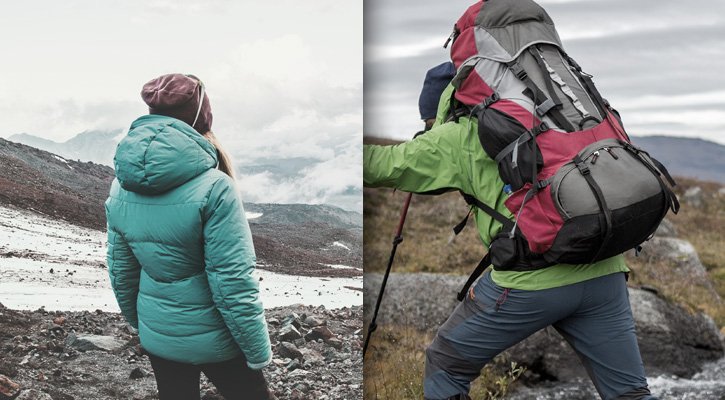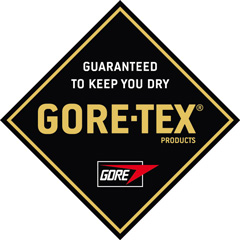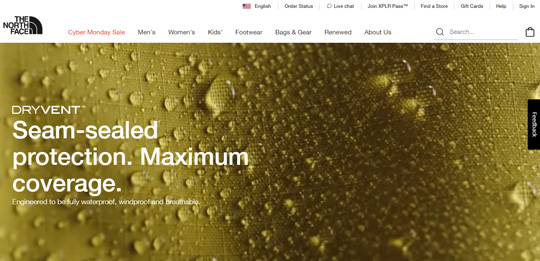
In today’s comparison review, we’ll be delving into the world of fabric technologies.
Gore-Tex® and DryVent™ are two of the most widely used fabrics in modern outdoor apparel, particularly jackets.
They each boast specific features that have earned them their deserved reputation.
By comparing these two types of fabrics, we’ll provide a comprehensive understanding of their strengths and differences. And by knowing them, you can make the right choice for your next outdoor gear purchase.
So, let’s get started and explore how they stack up against each other!
Key Points:
- Gore-Tex originated in the 1970s and it’s known for its ePTFE material.
- DryVent fabric was created by The North Face and is made of polyurethane.
- Both are waterproof, windproof, and breathable.
- Gore-Tex options and performance versions include Paclite, Active, Pro, Shakedry, etc.
- DryVent versions include DryVent 2L, 2.5L, and 3L.
- Both Gore-Tex and DryVent may include a DWR coating in some versions for water repellency.
- Gore-Tex has a higher water-column rating, while DryVent also offers full waterproofing.
- Gore-Tex is more breathable, while both fabrics are windproof.
- Gore-Tex’s ePTFE is known for durability but can be rigid. DryVent’s PU offers more flexibility and comfort.
- Gore-Tex is renowned for better longevity.
- In the end: both excel in different areas. Gore-Tex is highly breathable and durable. DryVent offers good performance at a lower price, with some compromise on longevity and breathability.
Contents:
1. Gore-Tex®
Gore-Tex® originated as a brand name in the 1970s under the company W. L. Gore & Associates, founded in 1959 by Wilbert L. and Genevieve Gore. A decade later, their son developed ePTFE (expanded PolyTetraFluoroEthylene), a durable and microporous material known for its weather resistance and low water adsorption.

Gore-Tex® Logo
This patented material found applications in various fields, including outdoor clothing, which is our focus today.
Gore-Tex® stands out due to its unique composition: it’s considered a membrane, a thin ePTFE membrane with over 9 billion pores per square inch, a laminate because it’s bonded between outer textiles and lining, and a technology that can be configured in different performance levels for different outdoor activities.
This combination gives rise to its key characteristics: waterproofness, windproofness, and breathability.
Gore-Tex® is not only fully waterproof and water repellent, but it also maintains these properties throughout its lifespan, also surpassing the required standard for windproofness of 1.0 cfm rating of air permeability, and offering exceptional breathability, allowing sweat to escape and regulating body temperature effectively.
Learn more: What is Gore-Tex® and How Does It Work?
The video will be loaded from YouTube.com, a third party. If you play it, you accept their terms of service, and their use of cookies.
Various Gore-Tex Options Available
Gore-Tex, known for its versatility, can be tailored into different options to accommodate a range of outdoor pursuits and athletic endeavors. Over time, the company has introduced multiple variations of this fabric technology.
Gore-Tex is generally divided into two primary categories:
the Original Gore-Tex range, intended for waterproof apparel and equipment;
and the Windstopper / Infinium Gore-Tex range, specifically engineered for non-waterproof clothing and gear suitable for dry, windy conditions.
The Original / Waterproof Gore-Tex range where we’ll be focusing on here, has various options that include:
Paclite: the most lightweight choice, it is easily packable and primarily tailored for casual and everyday use.
Active: the most breathable alternative, well-suited for intense athletic pursuits.
Pro: exceptionally durable and appropriate for various outdoor activities.
Shakedry: featuring high water repellency, it is lightweight and breathable, making it ideal for rainy sports activities such as cycling.
DWR (Durable Water Repellent) Coating
In certain Gore-Tex options, particularly in jackets, an application of DWR (durable water repellent) coating is administered to the outer layer of the garment to increase its water resistance and repellency.
Knowing that traditional DWR coatings are recognized for their adverse environmental impact, Gore-Tex has been actively seeking more eco-friendly substitutes.
Also, DWR coatings have a tendency to diminish in their water-repellent efficacy over time and necessitate reapplication to the garment.
2. DryVent™
DryVent™ fabric has been created by The North Face and it stands as one of the brand’s top-performing fabric technologies. This American outdoor clothing brand places a strong emphasis on the performance of its products.

DryVent: The North Face official website
The material utilized in DryVent™ is PU (polyurethane). Similar to Gore-Tex®, DryVent™ is a fabric that possesses the following qualities:
Waterproofness: Serving as a membrane, DryVent™ offers complete waterproofing and is further treated with a DWR finish to not only repel water but also cause it to bead off the jacket, reducing contact time.
Windproofness: Constructed with multiple layers, DryVent™ effectively blocks out winds.
Breathability: DryVent™ also exhibits high breathability, enabling perspiration to escape the body in the form of moisture vapor, and preventing overheating and excessive moisture accumulation inside the jacket.
Various DryVent Options
DryVent construction and performance options include:
DryVent 2L: The 2-layer construction of DryVent™ is a versatile choice for everyday exploration, often featuring a secondary fabric lining for added comfort and enhanced warmth.
DryVent 2.5L: Crafted for swift and dynamic activities, this lightweight and packable design utilizes a printed inner layer to deliver comfort and facilitate rapid moisture transfer to the exterior.
DryVent 3L: Designated for technical, high-performance clothing and gear, this fabric is exceptionally durable, breathable, and employed for prolonged expeditions in challenging conditions.
3. Comparison
Having gained an understanding of the composition and overall characteristics of each fabric, let’s now compare their features and determine which is better.
Waterproofness
A fabric’s waterproof rating is determined by its water column measurement, indicating the level at which the fabric begins to allow water penetration. A higher rating signifies the fabric’s greater ability to withstand various weather conditions.
Gore-Tex, known for its fully waterproof membrane with enduring capabilities, boasts a water column measurement exceeding 28,000mm, making it suitable for the most severe rain and snow conditions.
Conversely, DryVent possesses a rating of approximately 15,000mm, signifying its status as a fully waterproof membrane similar to Gore-Tex.
Both fabrics have also been treated with a DWR finish, enhancing their water-repellent properties in addition to their waterproof characteristics.
Breathability and Resistance to Wind
As previously noted, both fabrics are recognized for their windproof qualities, requiring no further elaboration.
However, beyond their windproof and waterproof attributes, the most crucial aspect is their breathability, where Gore-Tex unquestionably outperforms DryVent.
Gore-Tex exhibits a breathability rating exceeding 15,000 (G/M2/24h), effectively wicking moisture away without compromise.
In comparison, DryVent registers at approximately 12-15,000 (G/M2/24h), positioning it at a moderate level of breathability.
While both fabrics are suitable for outdoor pursuits, Gore-Tex performs better than DryVent in facilitating extensive physical activity.
Materials
The distinction here is significant, as Gore-Tex is constructed from ePTFE, which is more robust and slightly heavier than DryVent, crafted from PU (polyurethane).
However, the primary difference lies in how the material feels when worn. ePTFE tends to be rigid and at times may restrict movement, whereas PU is highly flexible and stretchable. So, DryVent can be regarded as more comfortable to wear, particularly for athletes.
Even though, Gore-Tex has recently created more stretchable options, such as Gore-Tex Pro Stretch.
Durability
This is another critical factor that distinguishes between the two.
Gore-Tex is renowned for its exceptional longevity, as ePTFE is an extremely durable material that withstands wear and remains impervious to various weather and environmental conditions. It exhibits resistance to abrasion and effectively repels stains for the most part.
In contrast, DryVent has a lower resistance to wear and tear due to the less robust nature of PU, making it more susceptible to deterioration over time, leading to a decline in durability and performance, particularly in humid and hot conditions.
4. Which is Better? Gore-Tex or DryVent?
After considering all aspects, the ultimate answer is: Both fabrics excel in different areas.
While Gore-Tex boasts high breathability and exceptional durability, it is not as lightweight and flexible as DryVent. Therefore, the choice ultimately depends on individual preferences and budget considerations.
For those looking for a jacket that consistently delivers peak performance and longevity, Gore-Tex may justify the investment.
However, if you have a lower budget, want good performance, and some compromise on longevity and breathability is acceptable, then jackets crafted from DryVent fabric may be your best option.
What do you think? Let us know in the comments below.
Read next:
Gore-Tex® vs Dermizax: Which is Better?
Sympatex vs Gore-Tex®: A Comparison
Gore-Tex® vs Texapore Fabric Technology: Which is Better?
Helly Tech® vs Gore-Tex: Which is Better?
